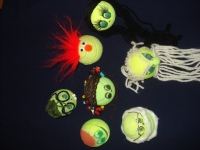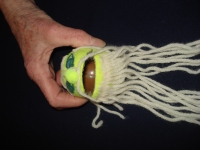
- Tennis balls.
- Sharp, sturdy knife.
- Permanent markers (Regular markers’ colors come off on hands and clothing.)
- Optional: yarn, sequins, glitter, feathers, googly eyes, and any other fun items that could be used to make the puppets into various characters. Caution: Do not use small items to decorate the puppets if there are infants and toddlers in the house. They might try to eat them and choke. With toddlers, I glue on glitter or colored sand for hair and draw on the eyes. 3-years and up can usually enjoy, without hazard, gluing on yarn and other items.
- Glue and rubber bands: Use rubber bands to hold on the items until the glue dries.
How to Make Them:
- Hold the ball with your non-dominant hand, on one side of the ball. We want to avoid knuckles being cut, so keep hands to the side of the knife.
- Squeeze the ball to create internal pressure. This makes cutting much easier. You can saw the knife back and forth for a long time and get nowhere if you do not create ball pressure.
- Saw the knife back and forth on the top of the ball, pressing down as you saw. Use the sawing motion until you break through. Then keep cutting until you have cut about ½ way through the ball. This is going to be the mouth.
- The ball is now ready to decorate. Some children need to be shown pictures of the characters from a familiar book, to give the children ideas of how to decorate their puppets. Others like to picture the characters in their minds and use their imaginations alone. Both ways develop their brains!
How to Use Ball Puppets:
- We first read a story with our children.
- We then make puppets of their favorite characters. (Perhaps on a later day.)
- At another time, we act out the stories with the puppets we have made to look like the characters.
- Squeeze the two sides of the ball at the ends of the slit. Squeezing makes the puppet’s mouth open and close like it is talking.
What is Developed?
- Tennis ball puppets require strength to make the puppet’s mouths open. This is great for physical development. Not only the finger and hand muscles get stronger but also the forearm muscles. The children are so intent on making the puppets talk that they don’t realize it is exercise!
- Using puppets to reenact stories reinforces the stories and helps children remember them.
- Puppets develop creativity, both in making and in using them.
- Acting out stories with puppets helps children’s vocabulary to explode!
- If your children use puppets with friends (Scout Troop, Sunday school classes, Birthday parties, Preschool, when friends visit) it helps the children socially. They learn to use words to express thoughts and feelings and take a perspective outside their own. This helps vocabulary and empathy as they try to express what a character does and feels. They get better and better at this as they age. The best a toddler can usually do is to growl nicely for the lion or say “Hi.” You may need to coach them on what their character can say. That’s a great way for them to learn. Celebrate their attempts. As children grow, they can do elaborate puppet shows, make different voices, and delight everyone!
- Note: Toddlers and young preschool-aged children usually have very short attention spans. They may switch stories in mid-stream or make up their own version of the story. You never know what they will think of. Just enjoy them and then do another activity. Keep your puppet time short and sweet and they’ll want to do it for longer periods of time in the years to come.
- Many children can also express emotions and work through hurts using puppets.
Related blog posts:


